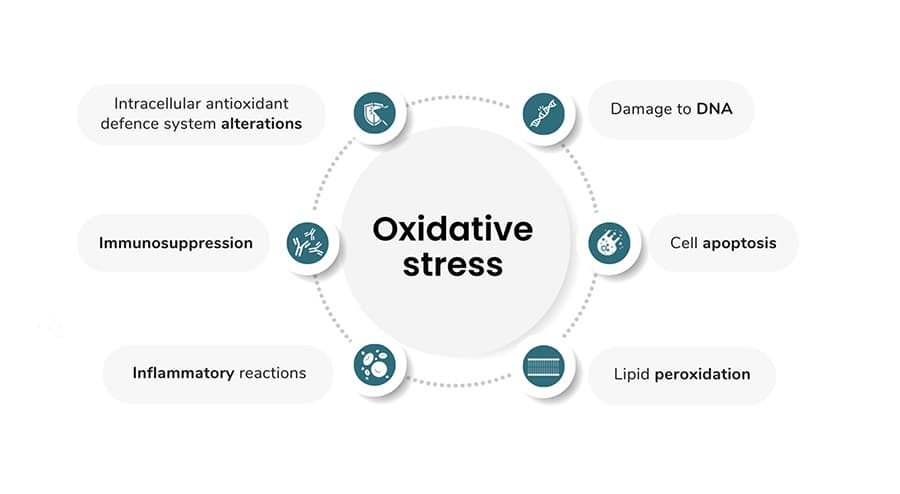- México, 33 Pol. Ind. Tecnoparc 43204 Reus (Tarragona) España
- +34 977 317 111
- bionte@bionte.com
The name mycotoxin, etymologically, is made up of the Greek word mykes (mold or fungus) and the Latin word toxicum (poison). Mycotoxins are low molecular weight secondary metabolites produced by fungi. Mycotoxigenic fungi can be divided into two classes, field and storage fungi.
Field fungi produce mycotoxins in the crop before harvest, such as Fusarium species, while storage fungi produce mycotoxins after crop harvest, mainly during storage, such as Aspergillus and Penicillium species. The temperature and activity of the water are mainly the most important factors that determine the production of mycotoxins.
In general, mycotoxigenic Fusarium species are more frequent in temperate regions, such as Western Europe and North America, and Aspergillus and Penicillium species are more likely to be found in (sub)tropical regions.
The main source of exposure to mycotoxins is ingestion of contaminated foods/animal feeds, but skin contact and inhalation of toxins are also considered sources of exposure. All mycotoxins are of fungal origin, but fungal growth does not necessarily mean the presence of mycotoxins. Furthermore, one species of fungus may produce more than one different mycotoxin and one mycotoxin may be produced by representatives of different genera of fungi. Today, there are more than 400 chemical compounds classified as mycotoxins.
Mycotoxins can cause a variety of illnesses as well as death in both humans and animals. The most important associated with human and animal diseases are aflatoxins (AF), citrinin, ergot alkaloids, fumonisins (FB), ochratoxin A (OTA), patulin, trichothecenes (mainly deoxynivalenol {DON}, nivalenol {NIV}, T-2 and HT-2 toxins) and zearalenone (ZEN). Recently, modified and emerging mycotoxins have been described (Broekaert et al., 2015) and their importance is increasingly taken into account.
Mycotoxins are the most common contaminants in foods and animal feeds worldwide and are considered a major risk factor for human and animal health.
Oxidative stress occurs in cells when the concentration of reactive oxygen exceeds the antioxidant capacity of the cell. Oxidative stress causes DNA damage, increases lipid peroxidation, protein damage, and cell apoptosis.
Oxidative stress and the generation of free radicals have been shown to be involved in the toxicity of the most common mycotoxins (Wang et al., 2016). Following exposure to mycotoxins, the imbalance between free radicals and antioxidant defense systems can lead to chemical damage to DNA, proteins, and lipids (Assi, 2017).
A series of effects related to oxidative stress produced in the case of mycotoxicosis by the most common mycotoxins have been reported (Silva et al., 2018):

Mycotoxin contamination in animal feed negatively affects animal health and performance (economic losses). The inclusion of a mycotoxin adsorbent in the animal feed is necessary to control this hazard and minimize these economic losses.
However, some mycotoxins such as trichothecenes are still difficult to adsorb. Therefore, it is recommended to include ingredients with antioxidant capacity to counteract the indirect effects of mycotoxins such as oxidative stress, immunosuppression, liver and intestinal damage.
The protective properties of antioxidants are probably due to their ability to act as free radical scavengers, thus protecting DNA, cellular proteins and lipids from mycotoxin-induced infections.
Many natural substances have been used for their ability to modulate oxidative stress caused by mycotoxins (Silva et al., 2018):
These ingredients inhibit the oxidation of substrates as a mode of action, and at a physiological level they reduce the production of free radicals and increase the antioxidant function of CAT, GSH, GPx and SOD, decrease the content of MDA, increase the level of GSH and modulate immunosuppression induced by mycotoxins.
At the cellular level, mycotoxins produce oxidative stress. Thus, counteracting the consequences of oxidative stress is indirectly counteracting the negative effects of mycotoxins.


The company that provides effective solutions against mycotoxins.
Calle México, 33. Polígono Industrial Tecnoparc.
43204 Reus (Tarragona) - España
Contact information
E-mail: bionte@bionte.com
Telephone: +34 977 317 111